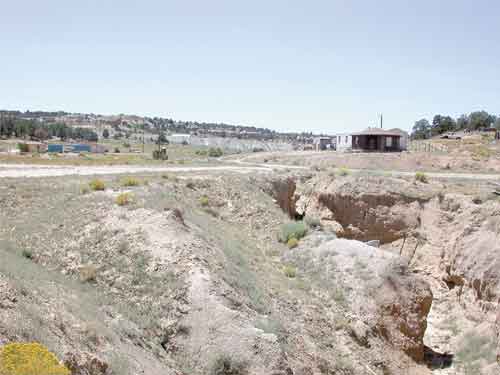Posted: July 25, 2008 by: Rob Capriccioso
The Environmental Protection Agency sent a multifaceted plan in June to the House Committee of Oversight and Government Reform, titled ''Health and Environmental Impacts of Uranium Contamination in the Navajo Nation.''
The 46-page report lays out a coordination strategy among the Department of Energy, the Nuclear Regulatory Commission, the IHS and the BIA over the next five years. It indicates that a combined $161 million from the agency's budgets will be used in the short term to prevent the spread of radioactive contamination on sites across the Navajo Nation. The total cost, tribal and environmental observers warn, could end up being much more.
Chiefly, the plan calls for cleanup of the Northeast Church Rock Mine near Gallup, N.M., as well as a survey of structures and wells for contamination in other parts of the Navajo Nation. Of the more than 500 mines on Navajo Nation, the agencies will work on assessing which mines and structures are most contaminated and those that could cause the most harm to humans due to radiation.
''It's the first coordinated effort that the five agencies have put together,'' said EPA spokesman Margot Perez-Sullivan. ''What's novel about it is that all of the agencies have sort of been working on the issue independently, but this is the first time that they've all come together.''
Perez-Sullivan said it's her understanding from agency people working on the ground that they are ''all working very cooperatively.'' The ultimate goal, she said, is to protect the health of the people who live in the region.
At the end of the five years accounted for in the plan, Perez-Sullivan said it is the EPA's hope, at least, to have addressed the most serious threats to public health. She expects that an assessment would occur in 2013 to see how far they've come.
A big part of the cooperation beyond the five federal agencies involves the Navajo Nation's own EPA. The division of the tribal government has been working for years to locate abandoned uranium mines, perform site assessments and build staff capacity to conduct its own fieldwork.
Stephen Etsitty, executive director of the Navajo Nation EPA, said the plan is significant because it brings a longstanding issue to the forefront of federal attention.
''The problem has always been the lack of ... resources in place to begin cleaning up for us to use and for the agencies to use,'' he said. ''We're ready to take on the responsibility of doing the cleanup and leading the effort.''
Etsitty said it's a goal of the Navajo Nation to track down any remaining companies that would potentially be responsible parties for paying for and helping with cleanup. Still, he noted, there will be a substantial need for the federal government to fund the efforts and ''own up to its responsibility.''
Many of the mines established in the Navajo region resulted directly from the U.S. government's attempt to ramp up its nuclear arsenal during the Cold War. Between 1944 and 1986, the government hired private contractors to mine 4 million tons of uranium ore on Navajo lands.
He said that past efforts at cleanup and containment came during times when the Navajo Nation had less of an ability to be directly involved with the processes. Some of the past work has also been compromised due to weatherization and other natural processes, so previously treated sites oftentimes need to be re-examined.
''We now have more of the tools and capacity to oversee what's going on to make sure that all of our concerns are being met,'' Etsitty said.
The Navajo Nation also recently passed its own version of the federal Superfund law, which allows Navajo officials to monitor and remove hazardous substances, pollutants and contaminants that could endanger the health and safety of residents.
Etsitty said the $161 million cost mentioned in the plan is likely just a beginning to the total funds needed to make headway. The tribe had laid down a figure of $500 million to Congress last fall for it to be able to do more of its own environmental work. Much of the money that hasn't even been widely discussed would involve testing groundwater for radioactive contamination.
Chris Shuey, of Southwest Research and Information Center, a nonprofit focused on the environment, said that to date the EPA has been most responsive of the federal agencies in dealing with contamination issues, but he doubts that the EPA and the other agencies have the money to do all that's needed. At the same time, he noted, the EPA has seen funding reductions that have been especially dramatic under the Bush administration.
''The government is going to have to figure out how it's going to cover the costs of cleanup and reclamation of many of these sites,'' Shuey said.
One of the questions he said needs to be asked by the agencies is whether they will need more money from Congress to carry out their mission.
''I don't think they really know how much they'll need. In any response to an environmental health type of problem, you've got to have an idea of how much it's going to cost to deal with the problem in order to secure funding at some point in the near or later future.''
Shuey feels that the report, which he called somewhat ''shallow,'' misses an important opportunity to project future costs.
The action plan came as a result of Rep. Henry Waxman, D-Calif., chairman of the oversight committee, calling for congressional inquiry into the contaminated sites. He had read a series in 2006, published in the Los Angeles Times, which detailed the extent of the problem and noted that Navajo cancer mortality rates have doubled since the mining started in the mid-20th century.
Waxman's committee is scheduled to meet again in September to discuss progress of the plan.
© 1998 - 2008 Indian Country Today. All Rights Reserved To subscribe or visit go to: http://www.indiancountry.com
